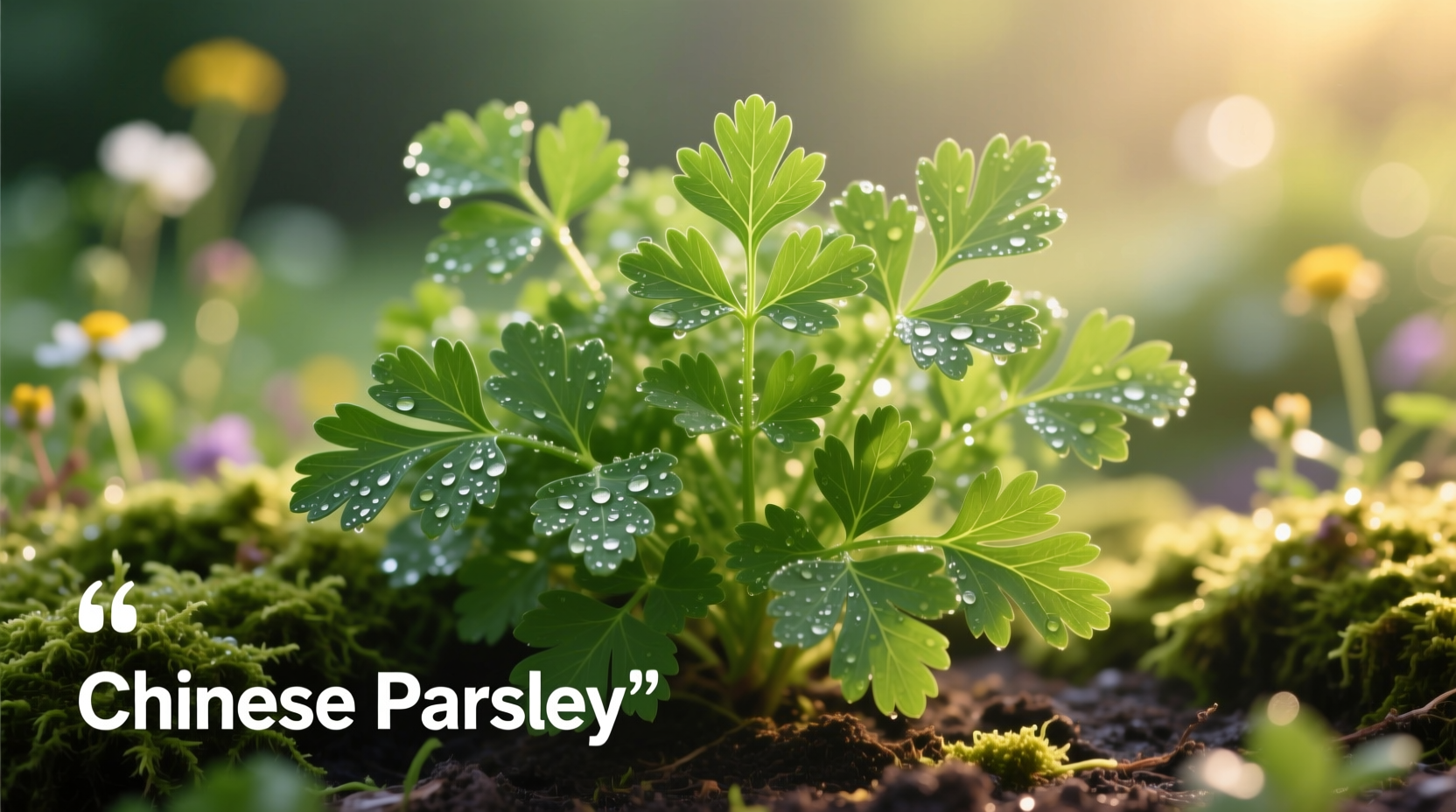Confused about what Chinese parsley actually is? You're not alone. Despite its name, Chinese parsley isn't parsley at all—it's a specialized celery variety fundamental to authentic Chinese cooking. This guide cuts through the confusion with precise botanical identification, culinary applications, and practical substitution advice you can trust.
What Chinese Parsley Really Is (And Isn't)
Chinese parsley (Apium graveolens var. secalinum) belongs to the celery family, not the parsley family (Petroselinum crispum). Also called small-leaf celery, napa celery, or Chinese celery, this vegetable features thin, hollow stalks and delicate leaves with a more concentrated flavor profile than Western celery varieties. Its distinctive aroma contains higher concentrations of phthalides, compounds responsible for celery's characteristic scent and potential health benefits.
According to the USDA Agricultural Research Service, Chinese celery contains approximately 30% more apigenin—a flavonoid with antioxidant properties—than standard celery varieties. This botanical distinction explains why substituting regular parsley or Western celery often fails to deliver authentic results in Chinese recipes.
| Characteristic | Chinese Parsley | Western Parsley | Cilantro |
|---|---|---|---|
| Botanical Family | Apiaceae (Celery) | Apiaceae (Parsley) | Apiaceae (Coriander) |
| Flavor Profile | Intense celery with slight bitterness | Grassy, mild | Citrusy, soapy (for some) |
| Stalk Thickness | Thin, hollow (1-3mm) | Thick, solid | No substantial stalks |
| Primary Culinary Use | Stir-fries, soups, braises | Garnish, finishing | Raw applications, garnish |
How to Identify Authentic Chinese Parsley
When shopping, look for these identifying features:
- Slender stalks (typically 1-3mm in diameter) that snap cleanly when bent
- Deep green color with possible purple tinges at the base
- Distinctive aroma—stronger celery scent with herbal undertones
- Delicate, fern-like leaves smaller than Western celery varieties
Food safety expert Dr. Xiuqin Zhang at China Agricultural University notes that authentic Chinese parsley should show no signs of wilting or yellowing, which indicates reduced volatile compound content and diminished flavor impact in cooking.

Traditional Culinary Applications in Chinese Cooking
Chinese parsley serves as one of the "holy trinity" aromatics (along with ginger and garlic) in many regional Chinese cuisines. Unlike Western celery used primarily in stocks, Chinese parsley's entire plant gets utilized:
In Cantonese cuisine, it's essential for:
- Stir-fried beef with Chinese parsley (芹菜炒牛肉)
- Winter melon soup with Chinese parsley
- Dim sum fillings for shrimp and pork dumplings
In Sichuan cooking, it appears in:
- Dry-fried Chinese parsley with chili
- Mapo tofu variations
- As a finishing garnish for hot pot
The timeline of Chinese parsley usage reveals its deep culinary roots:
- 200 BCE: First documented use in Chinese medicinal texts
- Tang Dynasty (618-907 CE): Became standard in imperial kitchen recipes
- Ming Dynasty (1368-1644): Featured in comprehensive agricultural manuals
- Modern Era: Remains essential in authentic Chinese restaurant kitchens worldwide
When Substitutions Work (And When They Don't)
Understanding context boundaries prevents recipe failures. Consider these guidelines:
Acceptable substitutions (with flavor adjustments):
- For soups and braises: Regular celery (use 50% more) + small parsley addition
- For stir-fries: Bok choy stems + fresh dill (1:1 ratio)
Unacceptable substitutions (will alter dish fundamentally):
- Regular parsley in place of Chinese parsley
- Cilantro as primary substitute
- Celery seed instead of fresh stalks
"Chinese parsley's unique combination of volatile compounds creates a flavor foundation that regular parsley simply cannot replicate," explains Chef Liu Wei, master of Chinese regional cuisines. "The moment you substitute regular parsley in a Cantonese stir-fry, you've created a different dish entirely."
Where to Find and How to Store Chinese Parsley
Locating authentic Chinese parsley requires knowing where to look:
Asian grocery stores typically stock it year-round, often labeled as:
- "Celery" (despite being different from Western celery)
- "Small-leaf celery"
- "Napa celery"
Farmer's markets in areas with significant Asian populations often carry it during spring and summer months. When selecting, choose bunches with crisp stalks and vibrant green leaves—avoid any with yellowing or limpness.
For optimal storage:
- Wrap in slightly damp paper towel
- Place in perforated plastic bag
- Store in vegetable crisper drawer
- Use within 5-7 days for peak flavor
Growing your own is feasible in temperate climates—plant seeds in partial shade with consistent moisture. The University of California Cooperative Extension reports that Chinese parsley reaches harvest maturity in 80-100 days from seed, with optimal flavor when harvested before flowering.
Maximizing Flavor in Your Cooking
Professional Chinese chefs employ these techniques to maximize Chinese parsley's impact:
For stir-fries: Add stalks first (they take longer to cook), then leaves in the last 30 seconds. This preserves the delicate leaf texture while allowing stalks to mellow their bitterness.
For soups and braises: Include whole stalks early in cooking, then remove before serving—similar to a bay leaf. This extracts maximum flavor without making the dish fibrous.
For dipping sauces: Finely mince leaves and combine with soy sauce, rice vinegar, and a touch of sesame oil for an authentic Cantonese accompaniment.
Nutritionally, Chinese parsley offers notable benefits. According to USDA FoodData Central, one cup (100g) provides:
- 28% of daily vitamin K requirement
- 15% of vitamin C
- Significant potassium and folate
- Only 16 calories
These nutrients remain more stable during cooking compared to regular parsley due to Chinese parsley's different cellular structure, making it both flavorful and nutritionally valuable in cooked applications.











 浙公网安备
33010002000092号
浙公网安备
33010002000092号 浙B2-20120091-4
浙B2-20120091-4